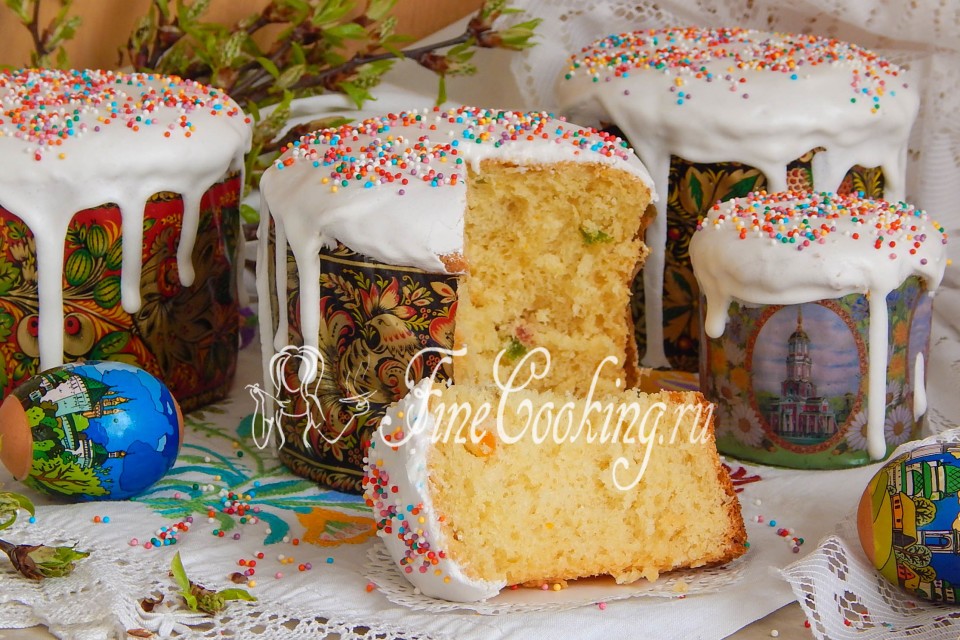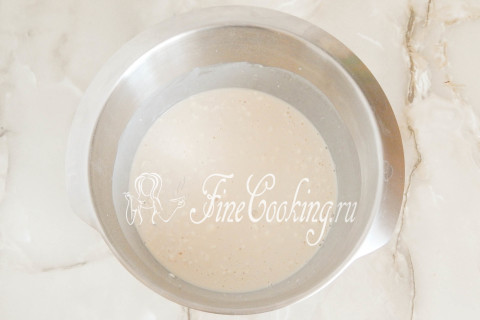Step 1
The recipe for grandma's Easter cakes includes products such as: wheat flour, milk, butter, sugar, egg yolks, fresh yeast (can be replaced with dry yeast — 12 grams), salt (required!), candied fruits (if you like, use raisins), cognac (rum is an excellent substitute), orange zest and a pinch of vanillin (or a teaspoon of vanilla sugar). In addition, we will make a glaze from egg whites, powdered sugar and lemon juice. Sorry, I forgot to put food in the photo. Also, choose what you will use to decorate the Easter cakes — I used confectionery sprinkles.
Step 2
Let's start preparing delicious Easter cakes by awakening the yeast. At the same time, we’ll check them for freshness. In warm (your finger feels a pleasant warmth) milk (50 ml) dissolve 1 tablespoon of sugar and 35 grams of pressed yeast. leave in a warm place for 15-20 minutes. I just put it in the microwave that is turned off.
Step 3
If after the allotted time (or even earlier) the milk bubbles and a foamy cap appears, the yeast is fresh and the cakes will rise perfectly. If the liquid mass remains in the same state, you can throw away the yeast and run to the store for new ones, otherwise you will simply ruin all the products. Yes, also make sure that you didn’t buy brewer’s yeast — Easter cakes are not made with it.
Step 4
Now we will make a dough — the basis for a rich yeast dough. What is it for? It's simple: the dough contains a lot of fat, so it will be difficult for the yeast to rise and make it fluffy. The role of the dough is to facilitate the work of the yeast. In a large container, mix 450 milliliters of warm milk and 200 grams of sifted wheat flour.
Step 5
Add yeast milk.
Step 6
Mix everything well. We cover the dishes with cling film or cover with a towel and send the dough to ferment in a warm place. I do this: turn on the oven to maximum for a couple of minutes, then turn it off and put a bowl of dough on a wooden board on the middle level. For the first 10 minutes the dough sits with the door ajar, and when it becomes not hot in the oven, but just warm, I close it. There the dough will spend 40-60 minutes. Fermentation time depends on the temperature and quality of the yeast. But in any case, the test for the readiness of the dough is the following: firstly, the mass has increased in size at least 2 times. And secondly: at the slightest movement of the dishes, the dough will begin to settle, even if it is barely noticeable.
Step 7
While the dough is rising, let's take care of the candied fruits. I took pineapple ones of different colors, since not everyone in our family likes raisins. Cut it into small pieces and soak in 50 milliliters of cognac (I have a bottle of good one for such purposes) until needed. No cognac — no problem: rum will help you. Of course, you can do it without alcohol at all, but believe me, the aroma is worth it.
Step 8
The dough is just about to arrive — we continue to prepare the dough for grandma’s Easter cakes (oh, I think grandma would be proud of me).
Step 9
In a separate bowl, combine 8 egg yolks, sugar (without the tablespoon that went into the yeast), vanillin, orange zest (I used dry) and salt (it is needed not only to balance the flavors, but also to control the yeast). In addition, we add cognac, which we drain from the candied fruits.
Step 10
Beat everything thoroughly with a mixer or whisk so that the granulated sugar is partially dissolved.
Step 11
Now add the egg mixture to the dough and mix everything. The photo does not show 2 components, since the egg mass is heavy and immediately sank to the bottom.
Step 12
Gradually add sifted flour. 200 grams are already included in the dough, that is, 650 grams remain. Well, in this matter you know: everyone’s flour is different. But still, don’t even think about filling the dough if you want really airy cakes. The maximum you can afford is to add another 100 grams, well, 150 at most. But it's better not to.
Step 13
This dough needs to be kneaded long and hard. In general, 1 hour is best. This is not a typo — 1 hour. But it is clear that doing this by hand is difficult and time-consuming. In general, knead for at least half an hour. If you have a dough mixer (a food processor with a hook attachment), great! They also knead for 30 minutes. The dough will be runny and very sticky at first. After 15 minutes of kneading, add soft butter in parts. Continue kneading for another 15 minutes. The hardiest ones knead even longer. Until it starts to come off your hands.
Step 14
As a result, the yeast sponge dough for Easter cakes is ready to rest.
Step 15
But first I will show you what it is like. She took some of the dough in her hand and dropped it into the bowl.
Step 16
You see, your hand is almost clean, despite the fact that the dough is very wet and not thick.
Step 17
We leave the dough to ferment in a warm place (again in a warm oven) until it grows 2.5-3 times. I can’t say exactly the time, but about an hour and a half for sure. Don't forget to cover the bowl so that the surface of the dough does not dry out. When the dough increases in size, you can add candied fruits or raisins. Just be sure to roll them in a tablespoon of wheat flour, otherwise they will settle to the bottom during baking (the dough is very tender).
Step 18
Stir in the additives for about five minutes and again send the dough to proof for another hour and an hour and a half.
Step 19
This time the dough grew faster — all the way to the top. It even partially stuck to the cling film.
Step 20
We knead it — either with our hands or with a spatula.
Step 21
Now we choose what we will bake grandma’s Easter cakes in. I have 6 paper forms. If you bake in dishes or tins, be sure to grease them with oil and place a circle of parchment paper on the bottom. We spread the dough into the molds to 1/3 of the height, no more. Cover with film and proof in a warm oven.
Step 22
Again, I won’t tell you the time. The main factor in the readiness of the dough before baking is its volume. When there is about 3 centimeters left to the edge of the pan, it’s time to bake. Preheat the oven to 200 degrees and bake the cakes at this temperature for 10 minutes. Then reduce to 175-180 degrees and bake until done. Depending on the size of the cakes and the features of your oven, it may take from 40 minutes to an hour.
Step 23
We check the finished Easter cakes for dryness: insert a thin wooden skewer into the center. If it comes out dry, the cakes are ready. You see, they didn’t turn very brown for me. And all because I didn’t lubricate their surface with anything before putting them in the oven. But, frankly speaking, I don’t see the need for this, since we will still be covering them with glaze. But if you like golden brown cakes, brush them with egg yolk mixed with a little water or milk before baking.
Step 24
Now let's prepare the glaze. In the recipe for cottage cheese cakes, I made it quite dense to get snow-white tall hats. This time I wanted the cakes to have characteristic streaks. To do this, combine two egg whites with powdered sugar and beat everything with a mixer at high speed. It doesn’t take long, you will see for yourself when the glaze is ready. At the end, add lemon juice and beat everything a little again.
Step 25
Apply the protein glaze directly onto the hot cakes. Just dip the whole cap into the glaze and then pour over the top. I do this as in the photo: I put the cakes on a wire rack, and place a baking sheet with paper under it. Everything stays clean and the paper is simply thrown away.
Step 26
And at the end (before the glaze is covered with a crust) we decorate the Easter cakes with whatever your heart desires.
Step 27
Happy Easter to you, my dears! All the best to you and your loved ones!



























